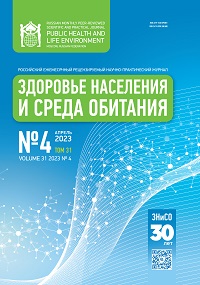
The Russian journal Public Health and Life Environment – PH&LE, its Russian transliterated title being Zdorov’e Naseleniya i Sreda Obitaniya – ZNiSO, is a monthly peer-reviewed journal published since 1993.
The journal presents relevant and up-to-date publications on preventive medicine, including:
- hygiene (human health effects of environmental and occupational factors);
- epidemiology (epidemiology of communicable and non-communicable diseases);
- public health, health care management and sociology (medical sciences) (public health effects of socioeconomic factors, health maintenance and promotion);
- social structure, social institutes and processes (sociological sciences) (effects of socioeconomic factors on public health and health care management); and
- occupational medicine (medical and biological sciences).
Monthly issues contain articles based on original research, as well as theoretical, methodological and review articles on a wide range of topics, reports on past scientific events, etc. The journal regularly publishes articles written by leading scientists and reports on the latest developments and exchange of experience in the field of preventive medicine.
High-quality independent peer review, commitment to the policy of the journal and high standards of work adopted by the editorial board allow authors to improve efficiency of their work for a wide range of researchers from all over the world.
The authors, members of the editorial board and editorial council of the journal represent different regions and countries, including Europe (Germany, Croatia, Norway, Belarus, Greece, and Finland), Asia (Kazakhstan), Southeast and East Asia (Vietnam and China), and Transcaucasia (Azerbaijan). The target audience includes public health and health care professionals from the Russian Federation and member states of the Eurasian Economic Union (EAEU).
Public Health and Life Environment is included in the list of peer-reviewed journals recommended by the Higher Attestation Commission for publishing the main results of dissertation research for the degrees of the Candidate and/or Doctor of Sciences.
The founder of the journal is the Federal Center for Hygiene and Epidemiology, Federal Budgetary Health Care Institution of the Federal Service for Surveillance on Consumer Rights Protection and Human Wellbeing (Rospotrebnadzor), Moscow, Russian Federation. The periodical Public Health and Life Environment – PH&LE is registered with the Federal Service for Supervision of Communications, Information Technology and Mass Media (Roskomnadzor); Mass Media Registration Certificate PI No. FS77-71110 of September 22, 2017 (print edition).
Editor-in-Chief: Anna Yu. Popova
Frequency: 12 issues a year with planned monthly circulation of 1,000 copies.
Journal metrics: 2021 RSCI five-year impact factor – 0.686; RSCI ten-year h-index – 87.
The journal adheres to the principles and requirements set forth by:
- The Committee on Publication Ethics (COPE);
- The World Association of Medical Editors (WAME) (the Editor-in-Chief is a member of the Association);
- The International Committee of Medical Journal Editors (ICMJE); (the journal is listed among those stating that they follow the ICMJE recommendations), and
- The Committee of Science Editors (CSE).
The journal also takes into account valuable experience and best practice of reputable international journals and publishers, including Elsevier.
Authors are not charged for editorial processing and publication of their articles.
Access policy declaration: Open access to all published materials is provided not earlier than six months after the date of printing.
The journal is indexed in the Russian Scientific Electronic Library eLIBRARY.RU, CYBERLENINKA, Russian State Library (RSL), Russian Science Citation Index (RSCI) on the Web of Science platform, Google (Google Scholar), Dimensions, LENS.ORG, NLM Catalog, Ulrich's Periodicals Directory, ROAD, EMBASE, VINITI RAN, etc.
Last updated: November 10, 2022








.png)



























